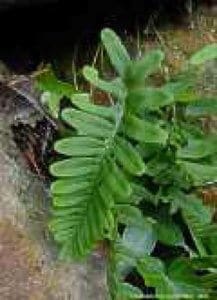In the rainforests of South America, a quiet, yet miraculous, fern, the Samambaia, takes root. These gentle plants grow to only 1-3 feet high with a similar diameter Its creeping root system (a thick, fleshy, white, or yellow rhizome) attaches itself to neighboring botanicals as it makes its way toward the sun. This botanical has been sought after for centuries by indigenous people for its health benefits and continues to be an important botanical today for dozens of tribes.
The Botanical
 Samambaia is part of the Polypodiaceae family of ferns. This is one of the most common families of ferns, encompassing approximately three-fourths of all known ferns. The name itself is derived from the Latin roots of “poly” meaning many and “podus” meaning foot, which perfectly describes the intricate, creeping structure of this hearty botanical.1 During seasons of extensive rainfall, plants sometimes sprout from the branches of large trees and can even be found thriving in the tops of palm trees.2 This plant has dozens of many colloquial names among tribes, as proof to its immense popularity, and is most commonly called Calaguala or Samambia in herbal markets.
Samambaia is part of the Polypodiaceae family of ferns. This is one of the most common families of ferns, encompassing approximately three-fourths of all known ferns. The name itself is derived from the Latin roots of “poly” meaning many and “podus” meaning foot, which perfectly describes the intricate, creeping structure of this hearty botanical.1 During seasons of extensive rainfall, plants sometimes sprout from the branches of large trees and can even be found thriving in the tops of palm trees.2 This plant has dozens of many colloquial names among tribes, as proof to its immense popularity, and is most commonly called Calaguala or Samambia in herbal markets.
Samambaia’s Chemical Make-Up
A look at the phytochemistry of Samambaia reveals a rich content of important chemicals, including flavonoids, alkaloids, and lipids. In fact, one group of lipids, sulfoquinovosyldiacylglycerols, has been attributed to many of its therapeutic actions and is the subject of many patents. Other significant compounds in Samambaia include adenosine, alkaloids, arachidonic acid, arabinopyranosides, calagualine, ecdysone, ecdysterone, eicosapentaenoic acid, elaidic acid, juglanin, kaempferols, linoleic acid, melilotoside, oleic acid, polypodaureine, ricinoleic acid, rutin, and selligueain.3
Properties
 Throughout history, the rhizomes and leaves of the fern have been used to support skin-related issues. As such, it’s become a source of holistic support to many people in South and Central America. The indigenous people of Honduras used it. The Boras Indians of Peru and the Witotos Indians in NW Amazon believed the leaves of the fern could be used. In Brazil, ancient legends regard Samambaia as a focus in their great-green wellness routines especially for supporting a healthy skin.4
Throughout history, the rhizomes and leaves of the fern have been used to support skin-related issues. As such, it’s become a source of holistic support to many people in South and Central America. The indigenous people of Honduras used it. The Boras Indians of Peru and the Witotos Indians in NW Amazon believed the leaves of the fern could be used. In Brazil, ancient legends regard Samambaia as a focus in their great-green wellness routines especially for supporting a healthy skin.4
For these reasons, Samambaia is considered a supplement to support overall system restoration as well as maintaining healthy skin conditions. Common uses are well known in local herb market all across the Americas.
Our Samambaia Liquid Extract contains only high-quality ingredients, including organic alcohol, distilled water, and 100% Samambaia Rhizome a Leaf. 10-15 drops per day is all that is needed to add Samambaia to your daily regimen. CLICK HERE to order today!
“Samambaia (Polypodium leucotomos)”, October 1, 2017. ↩
Das, Kuntal and John Wiling Einstein, “Samambaia – The future focus of Indian researchers in the treatment of psoriasis,” 2007. ↩
“Samambaia (Polypodium leucotomos)”, October 1, 2017. ↩
Das, Kuntal and John Wiling Einstein, “Samambaia – The future focus of Indian researchers in the treatment of psoriasis,” 2007. ↩

Reader Interactions